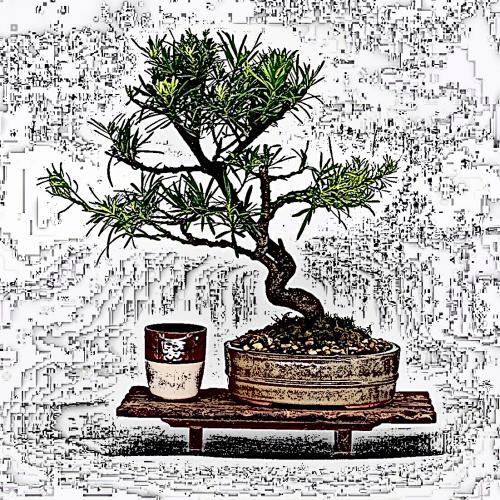Bonsai class 1

kathrynw%radian@natinst.com (Kathryn Whitworth) writes:
I like the idea of a bonsai class on the Net. Go for it! I'll find an appropriate shrub somewhere --There's a first question: any list of appropriate shrubs/trees? (If it's in the FAQ, I'll see it there next time it comes around.)
[The FAQ will roll around. Mike Bartolone did/does a great job of gathering information for the FAQ and regularly posting it. And, speaking of great jobs, thanks, Mike, for your blood, sweat and tears in pulling off rec.arts.bonsai. We seem to have garnered some new readers.]
Well, I imagine just about every shrubby or woody plant species on earth has probably been bonsai'd at one time or another. There are some species that don't have the right stuff, for instance because their leaves can never be coaxed to grow small enough to keep the tree-like appearance in scale. I am partial to junipers as beginner's material, maybe because that's the first thing my teacher had me do. They are plentiful and fairly inexpensive. Based on my two data points, they thrive in a wide variety of climates, from the frigid extreme of Minnesota, to sunny California. (Although, particular varieties no doubt prefer particular climates. What your local nursery sells is probably fine for your local climate.)
Maybe we should go ahead and do a "class". I would expect others to help with the information, even to the point of offering conflicting opinions. (We still haven't had a good bonsai flame war, yet!) We should probably go really slow, so that newbies who discover this group in the near future won't be too lost (but, I guess that cannot be avoided; people are always joining up in the middle of things). While I have shown friends how to make a bonsai in a matter of a couple hours (with occasional subsequent coaching), I envision this training as being very slowly paced and stretching perhaps over several months. That might be frustrating.
I'd suggest that folks who want to try a first bonsai go to a landscape nursery and purchase a "victim" for this. What you are after is a woody or shrubby plant that has the potential of looking like an interesting small-scale tree when a lot of its branches have been removed. Something in a gallon pot is probably about right (although bonsai come in almost all sizes, from a couple-inches tall that would sit in the palm of your hand, to forest-plantings of feet-tall trees that might take several people to lift).
A style is probably something to have in mind when selecting the material. And for a beginner's purpose an "informal upright" might be something simple to aim for. It's informal, so there are fewer rules to follow. It's upright, so look for something that is growing parallel to or away from the ground.
Something with a trunk at ground-level that is 1/4 to 3/4-inches would be good. If you can, find something with healthy roots radiating in all directions. Get in there and snoop and prod and poke. Try to find a trunk and large branch structure that has aesthetic appeal. (Finer branches are easily persuaded to grow in any direction you choose, but larger branches, of the 1/2-inch and up variety, are stubborn, and you are better off if they already exhibit a pleasing shape.) Twists and turns are desirable. A lot of nursery stock is designed to be placed in the ground and left to grow, so often features that are desirable in a bonsai are not desirable in a landscape planting. You can take that runty, beat up, bent over shrub that nobody else wants--a long as it is healthily growing.
I think bonsai do best as outdoor plants. That's a problem for a lot of people who cannot keep a tree outdoors. If you want an indoor bonsai, I do not have the experience for that. It definitely requires material that do well in the, frankly, harsh indoor environment. I do not have advice for you. By selecting material from a landscape nursery, you are committing to a plant that must be grown outdoors (with the occasional trip inside for a day or two to be appreciated).
So, get yourself a plant. Take your time. Look at some bonsai pictures if possible so that you can select a plant with potential. Ponder your choice carefully. Take your time. We won't do anything to it for a bit. Oh, and be sure to ask your subject if it really wants to become a bonsai. It is usually a different life path than the one the tree expected. The benefits, to compensate for the pain of training, are love and affection. Sometimes the tree will turn you down. Listen carefully.
And, once you have selected a plant, take it home, give it normal care for a potted outdoor plant, and study it a lot. Get to know every branch. Envision its final form when you have given it the shape of a mature tree. Start thinking about what branches can stay and which will have to go. For that matter, study mature trees around you. Really look at them. What makes a tree look mature? You have to reproduce those features in miniature. Notice the differences between your subject matter and the kind of tree you will want it to look like. This is a subtle matter. You see trees every day. Next time ponder them. What is their essence?
[God, I sound like Miyagi-san in Karate Kid. This isn't mysticism. But, this will take a while, and you might as well spend some of that time thinking.]
===
Class dismissed.
Any veterans have suggestions? Ideas? Warnings?


















